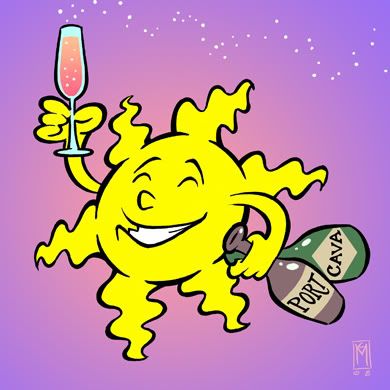Friday, January 23, 2009
Whole Grain Mixology
After relentless pressure from some of my fellow cocktail enthusiasts, I’ve finally pulled together my first batch of homemade falernum. Over the past year or so I’ve made many batches of various syrups, but this is my first dance with the Big F.
Like many who have gone before me, I decided to use Paul Clarke's venerable "#8" recipe. This particular recipe seems to have become the go-to blueprint for first-time falernum-makers, so who am I to buck a trend? (Actually, I buck trends pretty frequently, but anyway…) I’ll paste it here, but I strongly suggest you zip over to Paul’s site and check out the original post to get the full scoop and read the comments.
Falernum #8
- 6 ounces Wray & Nephew Overproof White Rum
- zest of 9 medium limes, removed with a microplane grater or sharp vegetable peeler, with no traces of white pith
- 40 whole cloves (buy fresh ones — not the cloves that have been in your spice rack since last Christmas)
- 1 1/2 ounce, by weight, peeled, julienned fresh ginger
Combine these ingredients in a jar and seal, letting the mixture soak for 24 hours. Then, strain through moistened cheesecloth, squeezing the solids to extract the last, flavorful bits of liquid.
Add:
- 1/4 teaspoon almond extract
- 14 ounces cold process 2:1 simple syrup (two parts sugar to one part water, shaken in a jar or bottle WITHOUT HEAT until all the sugar is dissolved)
- 4 1/2 ounces fresh, strained lime juice
Shake it all together and serve.
Normally I’m a “learn the rules before you break them“ kinda guy, but in this case I took a couple teeny liberties right out of the gate:
~ I didn’t use cold-process simple syrup
~ I didn’t use fresh cloves (but I did “rejuvenate” them with a light grind in a mortar & pestle)
These slight deviations didn’t seem to louse anything up. The final product ended up being wonderfully bright-tasting, citrusy, sweet and spicy. Just to satisfy my curiosity, I did a side-by-side taste test with a bottled brand, and the difference is shocking. The homemade stuff is profoundly better in so many ways, and given how easy it is to make, I’m pretty sure I’ll be opting for it over store-bought most of the time.
Random tip:
~ Rather than using cheesecloth, I used a flat-bottomed tea strainer. This allowed me to use a muddler to really mash the daylights out of the solids and get virtually 100% of the liquid loose.
Granted, I’m not distilling my own spirits or growing my own garnishes yet, but this is a step in the right direction. I’ve been observing other booze nerds concocting their own ingredients for awhile now, and I have to say I can see the appeal now that I’ve done likewise. I have an affinity for handmade, artisinal stuff, and cocktail crafting is clearly an arena where that approach really pays big dividends.
And now that I had a decent amount of a nifty-tasting, just-made cocktail ingredient, I immediately began casting around for a fun way to use it. Here’s something I came up with that I liked pretty well:
Shima Sour
2 oz. sake (I used Momokawa Diamond)
1 oz. homemade falernum
.25 oz. fresh-squeezed lemon juice
Shake well w/ ice and strain into ice-filled rocks glass. Garnish w/ slice of honeydew melon.
It’s my understanding that shima means “island” in Japanese, so I figure the name is appropriate given the two main ingredients. Sake and falernum may seem like an odd combo, but the Diamond is on the drier end of the spectrum and has noticeable fruit tones, (particularly melon) so I think it pairs well with the falernum. It’s also easy to calibrate to your taste- if you want the sake to come through a bit more, just pull back on the falernum...and vice-versa if you want it a bit sweeter.
Next time…hemp underwear!
Friday, January 16, 2009
Sample Jamboree and the Perils of Naming Drinks
I periodically receive samples of liquor in the mail. The purveyors of these fine products kindly package them up, send them on their way, and presumably hope I’ll like them enough to mention them by name.
I’m happy to say that in one way or another, I‘ve enjoyed almost everything that has arrived on my doorstep. There’s the occasional clunker, but by and large, my usual reaction is one of enthusiasm- I’m almost always jazzed to make a drink using a new ingredient.
Sometimes a list of recipes is included with my bottle of whatever. I like to browse these suggestions to get a sense of what other folks deem suitable uses for the product, but for me, the real fun is looking at something I’ve never tried before and thinking, “Hmmmm…what can I make with THAT?”
I’ll spare you a description of the “process” I employ when attempting to come up with a new drink. It’s untidy, inconsistent, and gloriously unhampered by any discernible logic. Guided mostly by my dubious intuition concerning what flavors and textures might work well together, I shamble around the kitchen in an orgy of trial-and-error. And every once in awhile something emerges that doesn’t seem half bad.
So I’ve got my recipe, I’m ready to write about it somewhere, and then I run right up against the hardest part of the whole project:
Naming the damn thing.
On rare occasions the drink just sort of names itself. But most of the time I’m struggling to come up with a moniker that isn’t too long, too silly, or too obscure. I often try to imagine a scenario wherein I’d order the proposed-titled drink at a bar. Would I immediately cringe upon saying it? Would I stumble over a lengthy string of syllables? Would the barkeep wordlessly greet my request with a withering expression of confusion and contempt?
See, to my way of thinking the best drink names have snap. They’ve got character and intrigue. And under ideal circumstances they should both elicit curiosity and communicate something. Longer drink names can do this, but I particularly like the ones that embrace brevity. (think “Zombie” vs. “Long Island Iced Tea” and you’ll see where I’m going).
So when it comes time to name an original drink, I usually start off completely paralyzed, and slowly try to find some aspect of the drink to latch onto and use as a beachhead. Here’s an example:
I recently received samples of Kilo Kai rum and cherry Heering. After tasting the sweet-ish and spicy Kilo Kai, the Heering seemed the perfect thing to match it up with. I decided that putting some whiskey in the mix to dry it out and fortify it wouldn’t necessarily be a bad idea either. I added in some Zirbenz pine liqueur (I’ll discuss my pathological need to employ unpopular and/or difficult ingredients in a another post) and a wisp of bitters and I thought I was onto something.
After some slight tinkering with proportions and taste-testing, the Bamboo Babe suggested the final touch should be rimming the glass and garnishing with a fresh piece of ginger. She was right- the flavor and aroma was exactly what was called for.
1 oz. Kilo Kai rum
1 oz. cherry Heering
.75 oz. rye
.5 oz. Zirbenz
1 dash Fee's Whiskey Barrel bitters
Shake with ice and strain into cocktail glass. Rub rim of glass with thin piece of freshly-sliced ginger and float in drink.
So now I had a drink that I was happy with. All that was left was the dreaded naming. As I looked over this concoction I observed the lustrous reddish color, pondered the tropical aspect of the rum, the classic pedigree of the rye, and the final flourish of…ginger. It was obvious- I’d call it the “Ginger Grant.”*
Then, during a quick Google search to check a detail or two, I ran across this post.
Dammit. I guess it’s true what they say about all the good ones being taken. Anyone got any ideas?
UPDATE 7/15/09: after much deliberation, I have dubbed this concoction the "Red-headed Castaway." This is not to be confused with the infamous "Red-headed Slut", which was officially eulogized and laid to rest last week during Tales of the Cocktail 2009.
*This would be obvious only to anyone who is familiar with the classic sitcom Gilligan’s Island. Hard as it is for me to conceive that there might be someone who is not acquainted with the show, I realize given my advanced age that it may not be the universal cultural touchstone it once was.
Friday, January 9, 2009
Iberian Dawn, Trans-Europe Express, and Thursday Drink Night
As has been noted elsewhere, there’s a great gig that happens every week here in the electronic ether. It’s called Thursday Drink Night, and it attracts all manner of adult beverage enthusiasts. It’s open to everyone, and it’s a hell of a lot of fun.
What exactly is Thursday Drink Night? I like to think of it as something vaguely akin to the TV show Iron Chef…but with booze. And a lot more participants.
Every Thursday night, these drink-tinkerers gather in the TDN chatroom to swap recipes based around a theme. Many drinks are conceived on-the-spot, and everyone gets a chance to discuss the results. It’s a nifty, no-pressure social event that never fails to entertain and educate. Plus, there’s no cover charge! (but it is BYOB).
Periodically, TDN is sponsored, which gives the attendees the chance to chat with the people behind the brands showcased that particular week. This was the case recently when Sandeman kindly sponsored the festivities and everyone got to fiddle with port. Many drink recipes were spawned that night, and yours truly contributed a couple to the roster:
Iberian Dawn
.5 oz. Sandeman tawny 10 yr. old port
.25 oz. Cointreau
2 dashes Fee’s peach bitters
Sparkling wine (I recommend a brut cava )
Put first 3 ingredients in Champagne flute. Fill with cava and enjoy!
Trans-Europe Express
1 oz. London Dry Gin
.75 oz. Sandeman Founder’s Reserve
.5 oz. St. Germain elderflower liqueur
Build over ice in rocks glass and squeeze in a lime wedge. Stir and enjoy!
The Trans-Europe Express is a great example of just how fun TDN can be. Soon after I submitted the recipe, a few people commented that they thought the drink would be better served by using Domaine de Canton ginger liqueur instead of St. Germain. This new version was immediately whipped up, assessed, and declared to be a perfectly suitable variation by those who tried it (assuming I’m recalling things correctly…the later hours of TDN often don’t make it to memory 100% intact. Fortunately, transcripts are available). This spirit of communal trial-and-error is, for me, a fundamental part of what makes TDN so enjoyable.
(By the way, if you prefer the version with the Canton, it’s called the Trans-Siberian Express.)
So if you’ve got A) access to the Web, B) a halfway decent liquor cabinet, and C) some free time on a Thursday evening, swing by and get in on the fun! Click here to belly up to the bar.
Subscribe to:
Posts (Atom)




